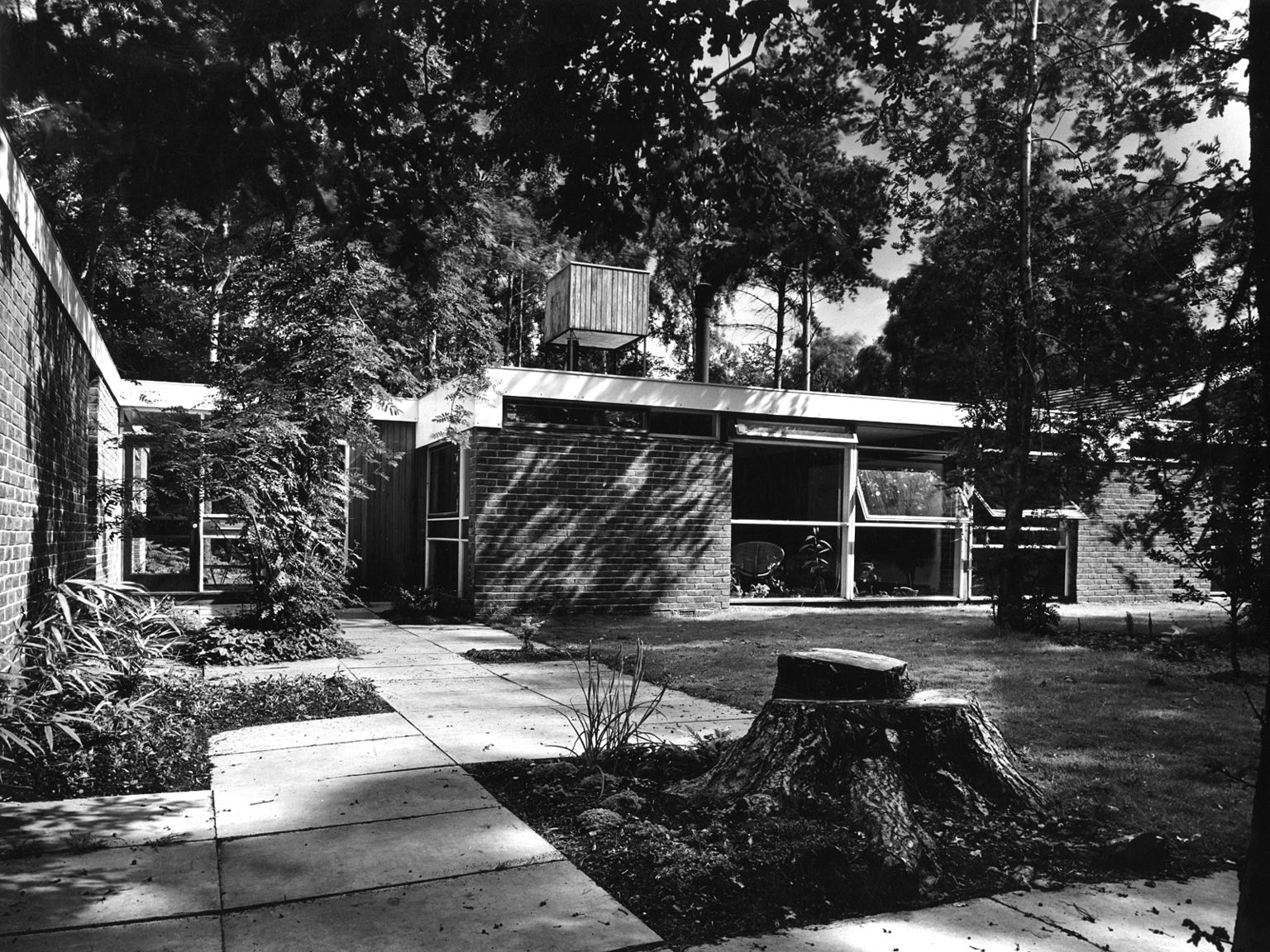The house that Edek built - and the secret suitcase kept inside
- Published

When Edward "Edek" Hartry and his wife Teresa designed and built their family home near Woking, they created a daringly modern building full of light.
Their glass and timber home stood out among the red-brick Tudor revival architecture of stockbroker Surrey - simple, open-plan and translucent.
It was the 1950s. Young architects were in the vanguard of imagining a new, post-War Britain.
The Hartrys though had more reason than most to believe that life could no longer rely upon old blueprints.
They were both Polish by birth, making futures as naturalised British citizens after a war that had made a graveyard of their country.
Edward, known always as Edek, spoke perfect English. He didn't talk much about the past, but that was not remarkable in that time and place.
He was busy with life, his children, his job, his sports cars.
Edek's suitcase
Edward died in 1967, Teresa in 2002.
It was not until then that their daughter Krystyna found a small suitcase full of papers that revealed her father, his story and his art.
Edward Hartry was born Edward Henrik Herzbaum in 1920, son of a Polish Jewish family then living in Vienna.
The Herzbaums moved back to Poland in the 1930s and settled in Lodz, where Edward enrolled as an architecture student.
He was 19 when Nazi Germany and Stalin's Soviet Union launched almost simultaneous invasions and tore up Poland between them, in 1939.
Edward's mother feared for her only child and sent him eastwards to hide in the city of Lvov.
Agents from the NKVD - the Soviet secret police - caught Edward in June 1940.
He was one of more than a million Polish men, women and children forced into cattle trains and deported in order to obliterate the Polish state.
Quickly and secretly, the NKVD murdered 20,000 Polish officers, scholars and other figures of standing - burying them in the forests of Katyn.
But most people were despatched to labour camps and prisons - mainly in the most remote parts of the Soviet Union.
Edward was sent to the Volga River, where he laboured as a logger and at a hydro-electric plant.
Edek's long journey
His diary reveals grotesque brutality, starvation and torture as routine.
It was impossible for him to draw at the time. Edward's pen and ink studies of this desperate period come from memory.
When Germany stormed into the Soviet Union in June 1941, Stalin released the surviving Poles - who were now allies.
Edward made his way thousands of kilometres south into Central Asia to join a mass of weak and starved men, women and teenagers.
They became a Polish army in exile, led by Gen Wladyslaw Anders.
"I've managed to buy a sketch book and some paints and I am making some sketches of the mountains," Edward wrote, bowled over by the colours, the heat and the landscape.
"The paints are not very good, the sketch book is made from terrible paper, so the sketches are even worse, but maybe someday I will be able to do some work based on them."
The Anders army sailed across the Caspian Sea out of the USSR to Iran, and from there served in Palestine, Iraq and Egypt alongside British forces through 1942 and 1943.
Iraq dazzled Edward.
"Here I would probably not use paints but would switch to ink. Such bright contrasts are better rendered by graphics.
"I have never before seen red, orange or purple mountains and I have seen so many green, yellow and brown skies," wrote Edward in Palestine.
In 1944, the Anders army was deployed to Italy, where it would fight the battle of its life, at Monte Cassino, the hill-top monastery that guarded the way to Rome.
Allied armies of many lands had already mounted three bloody assaults on Cassino and dropped thousands of tonnes of bombs.
On 12 May 1944, the Poles and other Allied armies finally drove the Germans out.
The road to Rome was open. The Polish flag flew from the monastery. The hillside was littered with the dead.
"Crushed stone, stumps of trees, shattered ammunition cases, helmets shot through, bloody bandages," Edward wrote.
"Bomb craters into which a two-storey building would fit, burnt-out tanks and pieces of artillery with barrels twisted like pasta."
"All these things create an image which is more theatrical and concentrated than in any movie or painting."
Edward's sketchbooks became filled with intimate drawings of his comrades as the War drew to a close.
These would be the last few months the soldiers of the Anders army would spend together.
The Poland they knew was destroyed, many families were dead or missing.
It was in Italy that Edward heard of the death of his mother in the Lodz ghetto, sometime in 1940-41.
Edward stayed on in Rome studying architecture until he moved on to the UK in 1946, along with tens of thousands of demobbed servicemen and women.
He took his degree and worked rebuilding bomb-damaged London for the Greater London Council and elsewhere.
Herzbaum became Hartry, and a bundle of drawings disappeared into a brown suitcase.
His modern light-filled new home in the London commuter belt was a fresh start - a new design for living.
Edward Herzbaum/Hartry was one of a generation of Polish-British emigres who cheated death not once but many times.
All of those who survive are now in, or approaching, their 90s.
Architects and engineers, musicians and teachers, many were instrumental in building modern Britain.
All carried deep personal losses and appalling stories of endurance, often kept secret for decades.
Find out more
Read Edward Herzbaum's diary here.
Listen to The Odyssey of Gen Anders' Army on the BBC iPlayer - from BBC World Service.
All images subject to copyright.